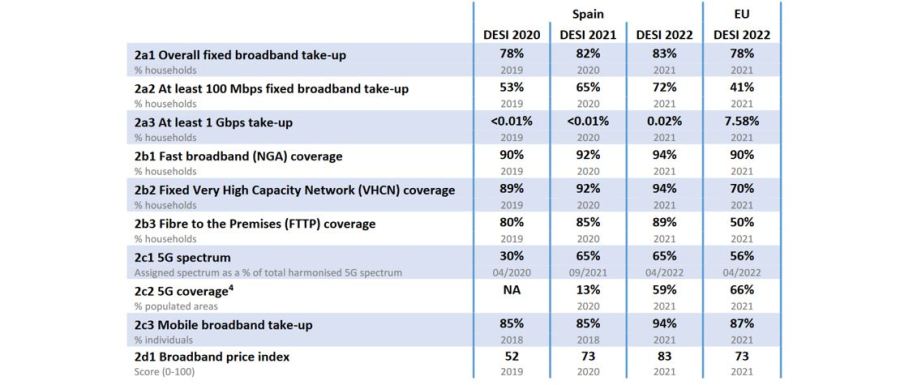Last July, the European Commission published the European Digital Economy and Society Index 2022 (DESI). This document is the European benchmark of progress and evolution in different digital components in the different Member States. Specifically, the DESI report covers the following indicators to measure the digital development of Member States:
1.- Human capital (digital skills and internet use)
2.- Digital infrastructures (connectivity)
3.- Integrating digital technology into business
4.- Digitisation of public services
The importance of this index must be understood in the framework of the ambitious objectives of the European Digital Compass and the process that Member States will have to implement to ensure their fulfilment. The different indicators monitored by DESI are perfectly correlated with the 2030 targets included in the Digital Decade Policy Agenda, as can be seen in the figure below.
Main Objectives of the Digital Decade 2030 Programme

The DESI index has steadily evolved in recent years. This evaluation system is dynamic and regularly updated to adapt and, in this way, accompany the evolution of the digital development of society in Europe.
For example, in this evolution, the connectivity indicator on 4G coverage has disappeared from the monitoring variables as they have reached compliance percentages above 99% in the different Member States. On the side of the additions, the FTTP coverage indicator has been included, once fiber deployments (FTTP) have reached a certain maturity in the different European countries.
Digital infrastructures and connectivity
One of the four variables monitored by DESI is digital connectivity. This component analyses indicators related to both the supply side (coverage) and the demand side (take-up) of both fixed and mobile networks. The comparative performance of the connectivity component in the different Member States is very illustrative.
Digital Economy and Society Index, Connectivity 2022

The main improvements compared to 2021 are a direct consequence of telecoms operators’ efforts in the mobile rollout of 5G and fibre networks.
The European average of 5G coverage has increased to 66% (+42 points compared to the previous year). On the demand side, there was a continued improvement in mobile broadband penetration, which reached 87% of the population.
Regarding fixed networks, it is worth highlighting the significant progress made in the Very High-Capacity Networks (VHCN) coverage providing capabilities similar to fibre. These networks have increased its coverage to 70% of households (+11 points vs 2021) thanks to the boost given by operators to fibre (FTTP) deployments at the national level.
Despite progress, rural coverage remains an unfinished business. Nearly 8.5% of these European households have no fixed network coverage and 32.5% of households still lack Next Generation Access (NGA) coverage. This is relevant considering that these networks would be the base for providing the Gigabit connectivity included in the 2030 objectives.
It should be noted that these areas are not totally isolated in terms of connectivity. 4G coverage at European level is above 99% while mitigating in the short term the negative effects of the lack of coverage in rural areas. Is precisely in this rural areas, where a great effort has been made to densify this type of mobile coverage in recent years, reducing the gap compared to urban areas.
In relation to the achievement of the 2030 Digital Compass targets, it should be noted that 21 of the 27 Member States have included initiatives to improve digital connectivity in their national recovery programmes. Italy, Spain, Poland and Greece are the countries that have dedicated the most significant amounts to these improvements.
Spain, on the podium of European connectivity
Spain is third in the European ranking, thanks to the major efforts made by operators in the deployment of fibre networks over the last few years and, more recently, in the promotion of 5G. However, in terms of mobile network performance, there are some indicators underperforming the European average.
Connectivity in Spain

In fixed networks, Spain is one of the Member States outperformeers, with metrics well above the European average in FTTP/VHCN coverage indicators. It is even more remarkable regarding the penetration of broadband products with a minimum of 100 Mbps. This being a symptom of the fact that end customers perceive a differential value to the performance offered by fibre-based connections.
Fibre deployment remains stable. The focus has shifted in recent years to rural areas, with strong support from state aid programmes. The result is an improvement in VHCN coverage for rural areas, amounting 71.5% of households (+7.3 points higher than in 2021). This is very remarkable in a context where white areas (those without fibre) are increasingly scarce.
As for mobile networks, indicators show a more modest performance. 5G coverage with values slightly below the European average has been affected by delays auctioning of the 700 MHz frequency band that finally took place in 2021. However, the improvement in coverage experienced in the last year, together with the upcoming auction of the 26 GHz band and the need to meet the coverage obligations associated with the 700 MHz auction, make it very likely that performance on this indicator will reach or even exceed the European average over the next few years.
Germany, the fast learner
In the case of Germany, there is an improvement from sixth position in 2021 to fourth in 2022, mainly due to the tremendous momentum experienced by 5G networks (+69 points vs 2021). Also noteworthy is the improvement, albeit more moderate, in VHCN network coverage (+19 points), compared to other European countries.
Connectivity in Germany

In fixed networks, Germany shows underperformance, mainly in those indicators related to the roll-out and penetration of fibre networks. The roll-out of fibre networks is still in its very early stages and being the cable network offering next generation network (NGA) capabilities.
In terms of Gigabit Society readiness, Germany has significantly improved VHCN coverage to 74.9% (mainly thanks to the cable upgrade to the enhanced DOCSIS 3.1 standard). However, the country is still lagging behind in the deployment of VHCN in rural areas (22.5% compared to the EU average of 37.1%). NAtion wide, only 15% of households have access to FTTP connection (compared to an EU average of 50%).
Therefore, on top of the digital divide between urban and rural areas and a lower penetration of high-speed services (100 Mbps take-up), the main challenge for Germany remains the roll-out of fibre networks to achieve the Digital Compass targets. To encourage this deployment, the Federal Government has earmarked EUR 12 billion to promote fibre connections from April 2021.
In contrast to fixed networks, the performance of mobile networks is remarkable in terms of both 5G coverage and 5G spectrum availability. Around 87% of the population already enjoys 5G services with the objective aiming to reach national coverage in the coming years.
What do we need to improve these indicators?
In the area of fixed networks, there is an urgent need to simplify, speed up and digitalise the bureaucratic procedures for civil works by obtaining permits. It is also necessary to facilitate access to infrastructures and public buildings in order to deploy very high-capacity networks. In the case of 5G, which requires greater capillarity than previous generations, public assets such as lampposts, bus shelters or traffic lights will become levers to densify coverage.
For 5G, measures are needed to incentivise deployment. For example, by facilitating operators’ access to spectrum assets under favourable economic conditions. Extending or renewing existing licenses, rather than auctioning these resources again, would also be very useful.
Finally, we cannot forget the importance of state aid for 5G deployment in rural areas for both active and passive infrastructures to accelerate connectivity goals and meet the 2030 targets.







